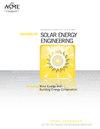用于太阳能集中发电的超临界CO2循环的滑动压力库存控制——分析和启示
IF 1.9
4区 工程技术
Q3 ENERGY & FUELS
Journal of Solar Energy Engineering-transactions of The Asme
Pub Date : 2023-08-14
DOI:10.1115/1.4063183
引用次数: 0
摘要
本文介绍了滑动压力库存控制(SPIC)在10MW超临界二氧化碳布雷顿循环集中太阳能发电中的应用,该循环包括印刷电路换热器。考虑在45°C、30°C和15°C的三种代表性环境条件下使用SPIC进行负载调节。虽然获得了从10MW到小于1MW的部分负载的宽操作范围,但也可以看到部分负载下的显著循环效率下降。不可逆性分析表明,回热器和涡轮机性能的恶化是部分负荷下循环性能退化的主要原因。然而,从10MW SPIC不可逆性研究中获得了有用的推论。随着换热器长度值的略微增加,发现在35巴/53巴之间运行的非冷凝1MW亚临界CO2循环与在88巴/210巴之间操作的1MW超临界CO2循环一样有效。对于1MW规模的应用,选择亚临界CO2循环的主要好处是,与相同功率规模的超临界CO2涡轮机(约67000 rpm)相比,涡轮机速度显著降低(约26000 rpm)。发现这些优点对于在35巴/53巴之间运行的基于空气的理想气体循环也是正确的,后者需要比亚临界CO2循环名义上更小的热交换器。然而,这些低压循环的工作流体的最终选择将取决于实际考虑,例如高温下的材料相容性、腐蚀考虑和成本。本文章由计算机程序翻译,如有差异,请以英文原文为准。
Sliding Pressure Inventory Control of a Supercritical CO2 cycle for Concentrated Solar Power- Analysis and Implications
This paper presents the use of Sliding Pressure Inventory Control (SPIC) for a 10 MW supercritical Carbon dioxide Brayton cycle for Concentrated Solar Power, incorporating Printed Circuit Heat Exchangers. Load regulation using SPIC for three representative ambient conditions 45 °C, 30 °C, and 15 °C are considered. While a wide operating range from 10 MW to less than 1 MW part load is obtained, a notable cycle efficiency decline at part load is also seen. Irreversibility analysis reveals that deterioration in recuperator and turbomachinery performance are primarily responsible for cycle performance degradation at part load. Nevertheless, useful inferences are obtained from the 10 MW SPIC irreversibility study. With a slightly increased value of heat exchanger length, a non-condensing 1 MW sub-critical CO2 cycle operating between 35 bar/53 bar is found to be as efficient as a 1 MW supercritical CO2 cycle operating between 88 bar/210 bar. The major benefit of choosing the sub-critical CO2 cycle for 1 MW scale applications is the significantly reduced turbomachinery speed (~26,000 rpm) in comparison with supercritical CO2 turbomachinery (~67,000 rpm) for the same power scale. These advantages are found to be true for air-based ideal gas cycles operating between 35 bar/53 bar too, with the latter requiring nominally smaller heat exchangers than the sub-critical CO2 cycle. The final choice of working fluid, however, for these low pressure cycles would depend on practical considerations, such as material compatibilities at high temperatures, corrosion considerations, and cost.
求助全文
通过发布文献求助,成功后即可免费获取论文全文。
去求助
来源期刊
CiteScore
5.00
自引率
26.10%
发文量
98
审稿时长
6.0 months
期刊介绍:
The Journal of Solar Energy Engineering - Including Wind Energy and Building Energy Conservation - publishes research papers that contain original work of permanent interest in all areas of solar energy and energy conservation, as well as discussions of policy and regulatory issues that affect renewable energy technologies and their implementation. Papers that do not include original work, but nonetheless present quality analysis or incremental improvements to past work may be published as Technical Briefs. Review papers are accepted but should be discussed with the Editor prior to submission. The Journal also publishes a section called Solar Scenery that features photographs or graphical displays of significant new installations or research facilities.

 求助内容:
求助内容: 应助结果提醒方式:
应助结果提醒方式:


